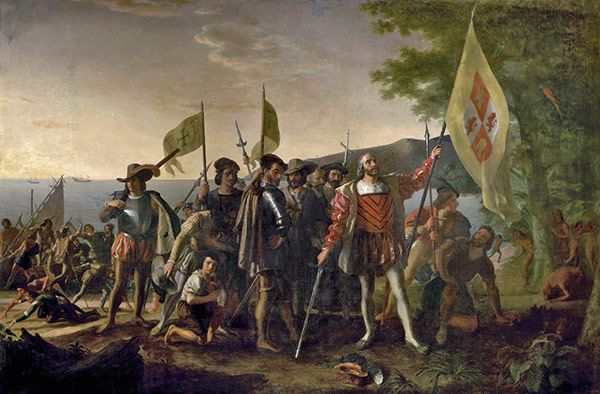This morning I helped my older son work on a short school assignment about whether Americans should continue to celebrate Columbus Day or replace it with some holiday celebrating America’s native inhabitants. My own thoughts on this have always been muddled since we shouldn’t be wasting a national day of remembrance on Columbus even if he’d been a great guy. We have many actual Americans who should be put in or put back in the national pantheon.
The actual man Columbus had little conscious understanding of or much to do with the reign of horrors his arrival in the Caribbean rapidly brought in its wake. (The story of European colonization of America and the catastrophic demographic decline and subjugation of its native peoples is fundamentally a story of epidemic disease. Absent disease Europeans would have been equally cruel and rapacious but far less successful in their efforts.) Columbus was personally brutal enough in his treatment of the native inhabitants of Hispaniola to justify his currently awful reputation. And in any case, Columbus the man as opposed to Columbus the impact or the effect hardly matters very much since the entire issue is one of symbols and commemoration, which are matters of the contemporary world, rather than history.
But the origins of the day are more complex and multivalent than the current debate lets on. As Brent Staples notes in this illustrated column, Columbus Day origins begin in a very different context: the efforts of Italian-American immigrants – often relatively dark skinned Sicilians and southern Italians who were a cultural world away from the Genoese Columbus – to find social acceptance as Americans in the late 19th and early 20th century.
The myth of the Italian-American Columbus was an ingenious end-run around the pride of place and status hierarchy of White Anglo-Saxon Protestant Americans. Italians weren’t alien looking and sounding newcomers entering the country in the late 19th century, unknown to and ignorant of the nation’s history and values. They were in fact here at the very beginning, long before English settlers even came into the picture. Without the person of the Italian Columbus (actually a subject of and sailing on behalf of the Spanish Crown of Castile, but whatever…) the whole national experiment wouldn’t even have been possible. Just because he never set foot on any ground the United States has ever held or claimed sovereignty over is just a quibble.
The first Columbus Day Parade in New York City dates to 1929 and in its current, more formalized form to 1944. Today the parade celebrates its 75th anniversary. The 1929 effort and the formalization in 1944 were both the handiwork of Generoso Pope, an Italian-American businessmen who owned a chain of Italian-language newspapers and was a major political figure in New York and national politics. A classic immigrant success story: arrived at 15, worked menial jobs, a millionaire by his thirties, the most prominent and powerful Italian-born American by the time he died at 59.
But as Staples notes, the veneration of Columbus as a sort of patron saint of Italian-Americanism isn’t simply one of benign acceptance. It was also about putting Italian-Americans firmly on the white side of America’s binary, black and white racial divide. In the South especially Italian immigrants were themselves targets of lynchings and the first Columbus Day, declared by President Benjamin Harrison in 1892, was a directly response to lynchings in New Orleans that left 11 Italian immigrants dead. There was no such response to the widespread lynchings of African-American which were reaching their peak at just this time. And as Staples notes, part of that was that there was an Italian government which was able to force a diplomatic crisis with the United States and successfully demand an indemnity for the killings.
In the early decades of Italian mass immigration, Italian immigrants were frequently portrayed as closer to blacks than whites or at least clearly lower on a racial hierarchy than other white Americans. In the South and particularly in Louisiana, they also often built businesses that catered to African-Americans, lived in African-American neighborhoods and intermarried with them.
In this sense, Columbus Day, Columbus Day Parades and the broader movement for acceptance of Italian-Americans as fully-fledged Americans by the 20th century wasn’t merely a matter of benign social acceptance but also involved, indeed was premised upon, buying into America’s ideology of white supremacy: Italians could be full-fledged Americans because they were white. Any ambiguity about where they fit on an imagined racialist spectrum had to be to firmly ironed out of the equation. And yet, in the hothouse politics of New York City, far from the Caribbean and distant from the history of the continent’s indigenous peoples, we cannot ignore the fact that Italian-Americans were genuinely underdogs, the targets of discrimination rather than its authors.






